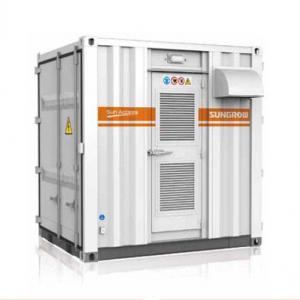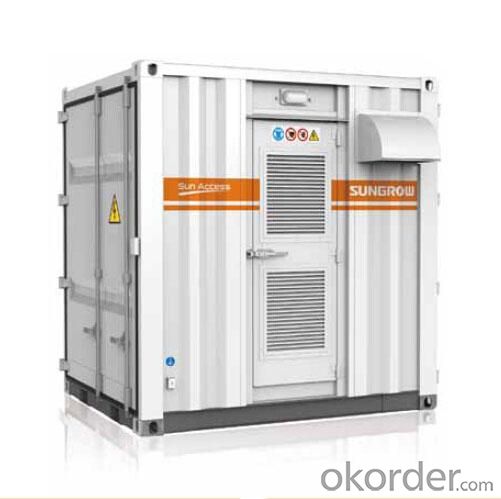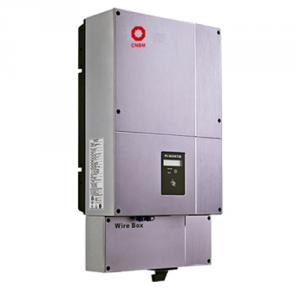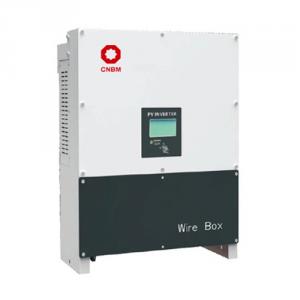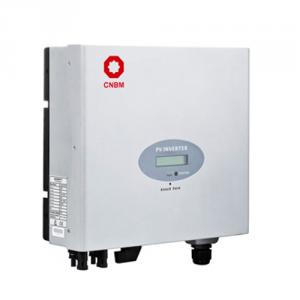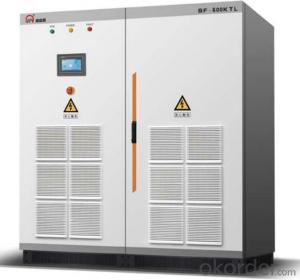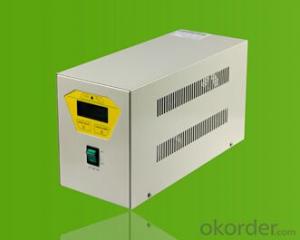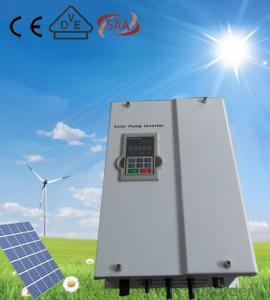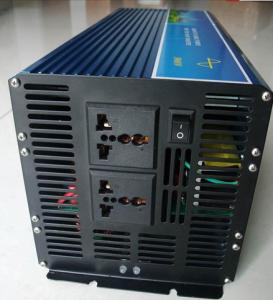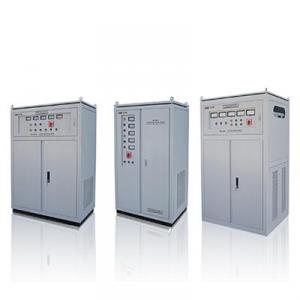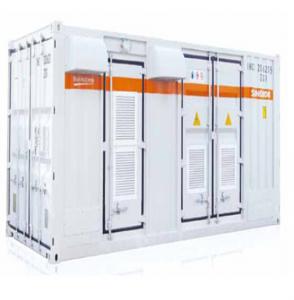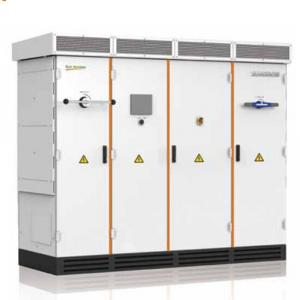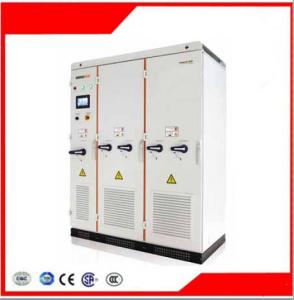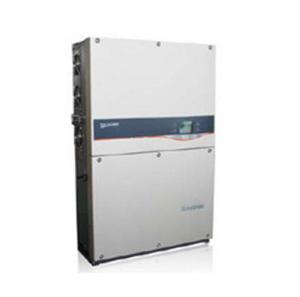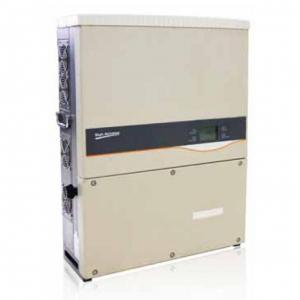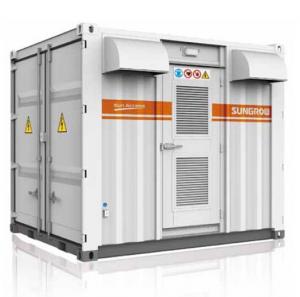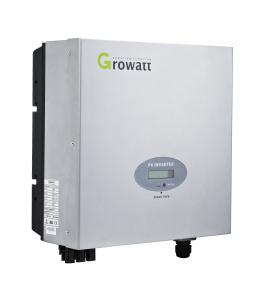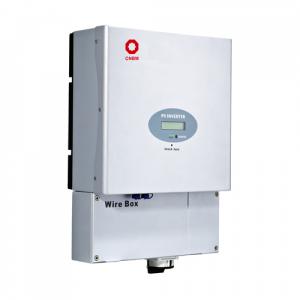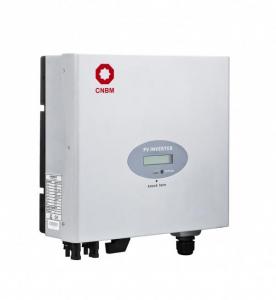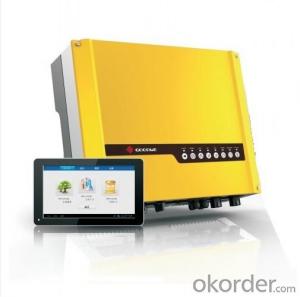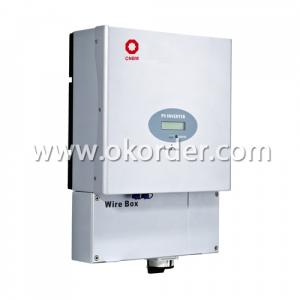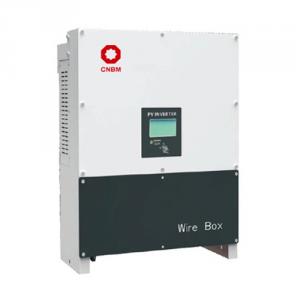Photovoltaic Grid-Connected Inverter SG1000TS
- Loading Port:
- China Main Port
- Payment Terms:
- TT or LC
- Min Order Qty:
- 50 unit
- Supply Capability:
- 1000 unit/month
OKorder Service Pledge
OKorder Financial Service
You Might Also Like
1. Structure of Photovoltaic Grid-Connected Inverter SG1000TS Description
A solar inverter, or PV inverter, or Solar converter, converts the variable direct current (DC) output of a photovoltaic (PV) solar panel into
autility frequency alternating current (AC) that can be fed into a commercial electrical grid or used by a local, off-grid electrical network.
It is acritical BOS–component in a photovoltaic system, allowing the use of ordinary AC-powered equipment. Solar inverters have
special functions adapted for use with photovoltaic arrays, including maximum power point tracking and anti-islanding protection.
Suitable for 50Hz grid, could be used in Asia, Australia and Europe.
2. Main Features of the Photovoltaic Grid-Connected Inverter SG1000TS
• 5 square meters area for megawatt-class equipment
• Transport and installation by forklift, more flexible and economical
• Open door design of three sides, easy for installation and maintenance
• More flexible for inner devices overall replacement
• Efficient cooling patented design
• Patented structure design of inlet and outlet, effective dust proof
• efficient heat insulation layer
3. Photovoltaic Grid-Connected Inverter SG1000TS Images
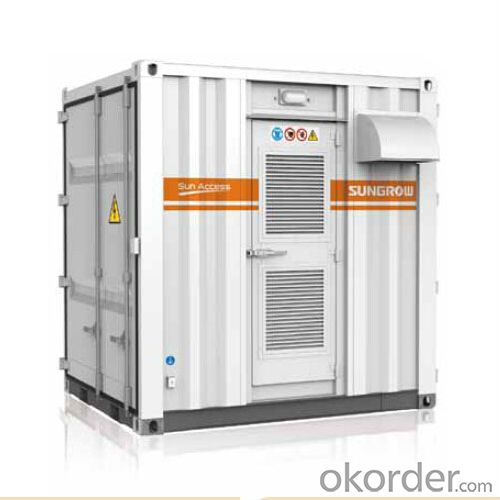
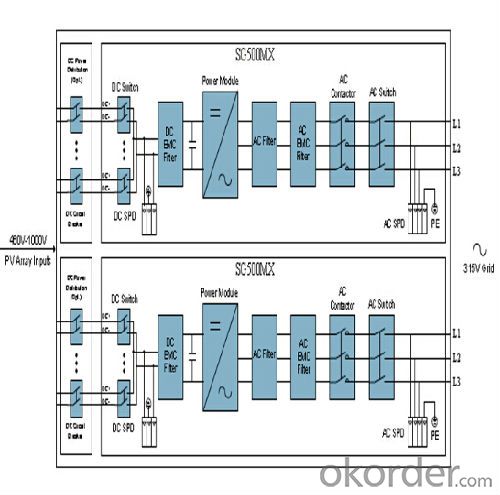
4. Photovoltaic Grid-Connected Inverter SG1000TS Specification
Input Side Data(DC) | |
Max. DC power (@ cos φ =1) | 1120kW |
Max. input voltage | 1000V |
Start voltage | 500V |
Min. working voltage | 460V |
Max. input current | 2440A |
MPPT voltage range | 460~850V |
Output Side Data(AC) | |
Rated power | 1000kW |
Max. output AC power | 1100kVA |
Max. output current | 2016A |
Max. THD | <3%(at nominal power) |
Rated grid voltage | 315V |
Grid voltage range | 252~362V |
Rated grid frequency | 50Hz/60Hz |
Grid frequency range | 47~52Hz/57~62Hz |
Power factor at rated power | >0.99 |
DC current injection | <0.5% of rated inverter output current |
Adjustable displacement factor | 0.9 (lagging) ~0.9 (leading) |
Efficiency | |
Max. efficiency | 98.70% |
European efficiency | 98.50% |
Protection | |
DC overvoltage protection | Yes |
AC overvoltage protection | Yes |
Grid monitoring | Yes |
Ground fault monitoring | Yes |
Overheat protection | Yes |
Insulation monitoring | Yes |
General Data | |
Dimensions(W×H×D) | 2538X2470X2050mm |
Weight | 4200Kg |
Operating temperature range | -35~50℃ |
External auxiliary supply voltage (Opt.) | 380V |
Cooling concept | Temperature controlled air-cooling |
Degree of protection | IP54 |
Max. permissible value for relative humidity (non-condensing) | 0~95%, non -condensing |
Max. altitude | 6000m ( >3000m derating) |
Communication port/protocols | Standard:RS485/ Modbus、Internet |
Options: CDT、DNP3.0、101、103、104、GPRS/CDMA module | |
5. FAQ of Photovoltaic Grid-Connected Inverter SG1000TS
Q1. What is the difference between inverter and solar inverter?
A1. Inverter only has AC inpput, but solar inverter both connect to AC input and solar panel, it saves more power.
Q2. What is the difference between MPPT&PWM?
A2. MPPT has higher efficiency, it can track the max power point and won't waste energy.
- Q: Can a solar inverter be used with a solar-powered air cooling system?
- Yes, a solar inverter can be used with a solar-powered air cooling system. The solar inverter is responsible for converting the direct current (DC) generated by the solar panels into alternating current (AC) that can be used to power the air cooling system. This allows the system to operate efficiently using solar energy.
- Q: Can a solar inverter be used with a solar-powered agriculture system?
- Yes, a solar inverter can be used with a solar-powered agriculture system. A solar inverter is an essential component that converts the direct current (DC) electricity generated by solar panels into alternating current (AC) electricity, which is compatible with most electrical appliances and equipment. In the context of a solar-powered agriculture system, a solar inverter would be necessary to convert the electricity produced by the solar panels into the appropriate form for powering agricultural machinery, irrigation systems, or any other electrical needs on the farm.
- Q: Can a solar inverter be used with batteries?
- Yes, a solar inverter can be used with batteries. In fact, many solar energy systems use a solar inverter to convert the DC (direct current) power generated by solar panels into AC (alternating current) power that can be used by household appliances. By integrating batteries into the system, excess solar energy can be stored for later use during periods of low sunlight or at night, providing a reliable and continuous power supply.
- Q: Can a solar inverter be used for commercial-scale solar installations?
- Yes, a solar inverter can be used for commercial-scale solar installations. Solar inverters are essential components of any solar PV system, converting the DC electricity generated by solar panels into AC electricity suitable for commercial use. They are available in various sizes and capacities, allowing them to accommodate the power requirements of large-scale commercial installations. Additionally, advanced features like grid-tie functionality and monitoring capabilities make solar inverters suitable for integration into commercial-scale solar installations.
- Q: Can a solar inverter be used in a commercial solar system?
- Yes, a solar inverter can be used in a commercial solar system. In fact, it is an essential component as it converts the direct current (DC) generated by the solar panels into alternating current (AC) that can be used to power commercial buildings and equipment. The solar inverter ensures efficient and reliable energy conversion, making it suitable for both residential and commercial solar installations.
- Q: Can a solar inverter be used in areas with high levels of lightning activity?
- Yes, solar inverters can be used in areas with high levels of lightning activity. However, it is important to ensure that the solar inverter is properly grounded and installed with appropriate lightning protection measures to minimize the risk of damage caused by lightning strikes.
- Q: Can a solar inverter be used off-grid?
- Yes, a solar inverter can be used off-grid. Off-grid solar systems typically include batteries to store excess energy generated by the solar panels. The solar inverter converts the direct current (DC) power from the solar panels into alternating current (AC) power, which can be used to power household appliances and devices. This allows for the use of solar energy even when there is no access to the main electricity grid.
- Q: What is the role of a voltage regulator in a solar inverter?
- The role of a voltage regulator in a solar inverter is to maintain a consistent and stable output voltage despite fluctuations in the input voltage from the solar panels. It ensures that the electricity generated by the solar panels is converted and delivered to the connected devices or grid at the required voltage level, preventing any damage to the devices and optimizing the overall efficiency of the solar power system.
- Q: Can a solar inverter be used with different types of energy storage systems?
- Yes, a solar inverter can be used with different types of energy storage systems. Solar inverters are designed to convert the direct current (DC) electricity produced by solar panels into alternating current (AC) electricity that can be used in homes and businesses. They can be connected to various types of energy storage systems, such as batteries, supercapacitors, or even grid-connected systems, allowing for efficient storage and utilization of solar energy.
- Q: Can a solar inverter be used with different types of grounding materials?
- Yes, a solar inverter can be used with different types of grounding materials. Solar inverters are designed to be compatible with various grounding systems, such as ground rods, ground plates, and grounding grids. The choice of grounding material may depend on local regulations, soil conditions, and the specific requirements of the solar installation. However, it is important to ensure that the chosen grounding material meets the safety standards and provides proper electrical grounding for the solar system.
Send your message to us
Photovoltaic Grid-Connected Inverter SG1000TS
- Loading Port:
- China Main Port
- Payment Terms:
- TT or LC
- Min Order Qty:
- 50 unit
- Supply Capability:
- 1000 unit/month
OKorder Service Pledge
OKorder Financial Service
Similar products
Hot products
Hot Searches
Related keywords
